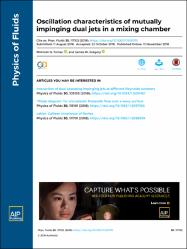| dc.contributor.author | Tomac, Mehmet N. | |
| dc.contributor.author | Gregory, James W. | |
| dc.date.accessioned | 2019-07-29T09:36:40Z | |
| dc.date.available | 2019-07-29T09:36:40Z | |
| dc.date.issued | 2018 | en_US |
| dc.identifier.citation | PHYSICS OF FLUIDS Volume: 30 Issue: 11 Article Number: 117102 DOI: 10.1063/1.5051731 | en_US |
| dc.identifier.issn | 1070-6631 | |
| dc.identifier.issn | eISSN: 1089-7666 | |
| dc.identifier.other | Accession Number: WOS:000451733300049 | |
| dc.identifier.other | DOI: 10.1063/1.5051731 | |
| dc.identifier.other | Article Number: 117102 | |
| dc.identifier.uri | http://acikerisim.agu.edu.tr/xmlui/handle/20.500.12573/73 | |
| dc.description.abstract | In this study, we consider the oscillatory behavior of mutually impinging jets in an enclosed, domeshaped mixing chamber. The frequency of the impinging jet oscillations is dictated by the flow rate, with the oscillatory behavior being grouped into three regimes: a low flow rate regime (Re < 1500), a transition regime (1500 < Re < 2000), and a high flow rate regime (Re > 2000). The detailed characteristics of the oscillations in the high flow rate regime (Re = 6800 in the present study) are investigated through simultaneous frequency and refractive-index-matched particle image velocimetry measurements. The oscillation mechanism in the high flow rate regime was found to be similar to that of the other two regimes, where jets collide and interact in an oscillatory manner. However, in the high flow rate regime, there is a distinct and phase-evolving process of saddle point formation and jet bifurcation that is not present at the lower flow rates. The jet bifurcation process is also distinctly related to the balance of vortical structures inside the mixing chamber, and saddle point formation plays a key role in the internal and external flow field of this configuration. The external sweep angle of the exiting jet increases with the flow rate throughout the low and transition flow rate regimes, but a constant sweep angle was found to persist in the high flow rate regime. Thus, formation and location of the internal saddle point is directly linked to the external sweep angle of the jet. (C) 2018 Author(s). | en_US |
| dc.description.sponsorship | U.S. Department of Energy (DOE) GATE Fellowship OSU Center for Automotive Research (CAR) Department of National Education (MEB) of Turkey | en_US |
| dc.language.iso | eng | en_US |
| dc.publisher | AMER INST PHYSICS, 1305 WALT WHITMAN RD, STE 300, MELVILLE, NY 11747-4501 USA | en_US |
| dc.relation.ispartofseries | PHYSICS OF FLUIDS;Volume: 30 Issue: 11 | |
| dc.rights | info:eu-repo/semantics/openAccess | en_US |
| dc.subject | SELF-SUSTAINED OSCILLATIONS | en_US |
| dc.subject | STAGNATION POINT OFFSET | en_US |
| dc.subject | NUMERICAL EXAMINATION | en_US |
| dc.subject | DYNAMICS | en_US |
| dc.title | Oscillation characteristics of mutually impinging dual jets in a mixing chamber | en_US |
| dc.type | article | en_US |
| dc.contributor.department | AGÜ, Mühendislik Fakültesi, Makine Mühendisliği Bölümü | en_US |
| dc.contributor.institutionauthor | | |
| dc.identifier.doi | 10.1063/1.5051731 | |
| dc.relation.publicationcategory | Makale - Uluslararası Hakemli Dergi - Kurum Öğretim Elemanı | en_US |


















